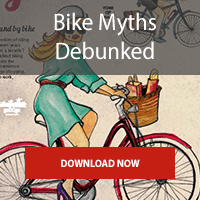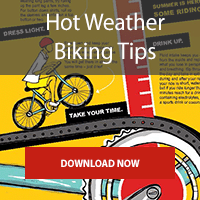
Explore
Bike Facilities
Bike Box
Bike Lanes
Buffered Bike Lanes
HAWK Beacon
Green Bike Lanes
Multi-Use Trails
Protected Bike Lanes
Sharrows
Sidewalks
Wayfinding
Infographics
Bike Myths Debunked
Cold Weather Biking Tips
Hot Weather Biking Tips
Additional Resources
Shared Micro-Mobility Devices
Bicycle Parking
Bike Shops
Fixit Stands
Bike Facilities
Bike Box
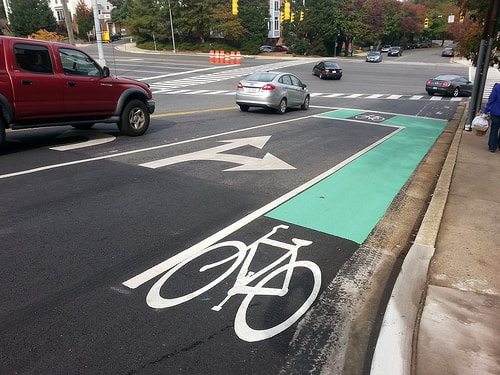 A bike box is a designated area at the head of a traffic lane at a signaled intersection that provides bicyclists with a safe and visible way to get ahead of queuing traffic during the red signal phase. A bike box has been added at the southern side of the intersection of Veitch Street and Lee Highway in Courthouse and is particularly useful for improving interactions between people in cars turning right from Veitch Street onto Lee Highway and people on bikes going straight on Veitch to get to the Custis Trail. For cyclists, when the traffic light is yellow or red, bicyclists should enter the bike box from the approaching bike lane and stop before the crosswalk. Once a cyclist is in the bike box, they should position themselves according to the direction they are intending to go. Cyclists turning left should move to the left of the bike box and signal a left turn. Cyclists proceeding straight through the intersection should position themselves in front of the through lane. Cyclists turning right, should move close to the right edge of the roadway and signal a right turn. When the light is green, cyclists may proceed as normal but should be aware of right-turning motorists, especially while in the green bike lane in the intersection. For motorists, when the traffic signal is yellow or red, vehicles must stop behind the white stop line and not top of the green bike box as it should be kept clear for cyclists to use. Typically at bike box locations, right turns on red are not be permitted. When the light turns green, motorists and cyclists may move through the intersection as usual, with cyclists going first. Motorists turning right on green should signal and watch for cyclists to the right, especially in the green bike lane in the intersection.
A bike box is a designated area at the head of a traffic lane at a signaled intersection that provides bicyclists with a safe and visible way to get ahead of queuing traffic during the red signal phase. A bike box has been added at the southern side of the intersection of Veitch Street and Lee Highway in Courthouse and is particularly useful for improving interactions between people in cars turning right from Veitch Street onto Lee Highway and people on bikes going straight on Veitch to get to the Custis Trail. For cyclists, when the traffic light is yellow or red, bicyclists should enter the bike box from the approaching bike lane and stop before the crosswalk. Once a cyclist is in the bike box, they should position themselves according to the direction they are intending to go. Cyclists turning left should move to the left of the bike box and signal a left turn. Cyclists proceeding straight through the intersection should position themselves in front of the through lane. Cyclists turning right, should move close to the right edge of the roadway and signal a right turn. When the light is green, cyclists may proceed as normal but should be aware of right-turning motorists, especially while in the green bike lane in the intersection. For motorists, when the traffic signal is yellow or red, vehicles must stop behind the white stop line and not top of the green bike box as it should be kept clear for cyclists to use. Typically at bike box locations, right turns on red are not be permitted. When the light turns green, motorists and cyclists may move through the intersection as usual, with cyclists going first. Motorists turning right on green should signal and watch for cyclists to the right, especially in the green bike lane in the intersection.
Bike Lanes
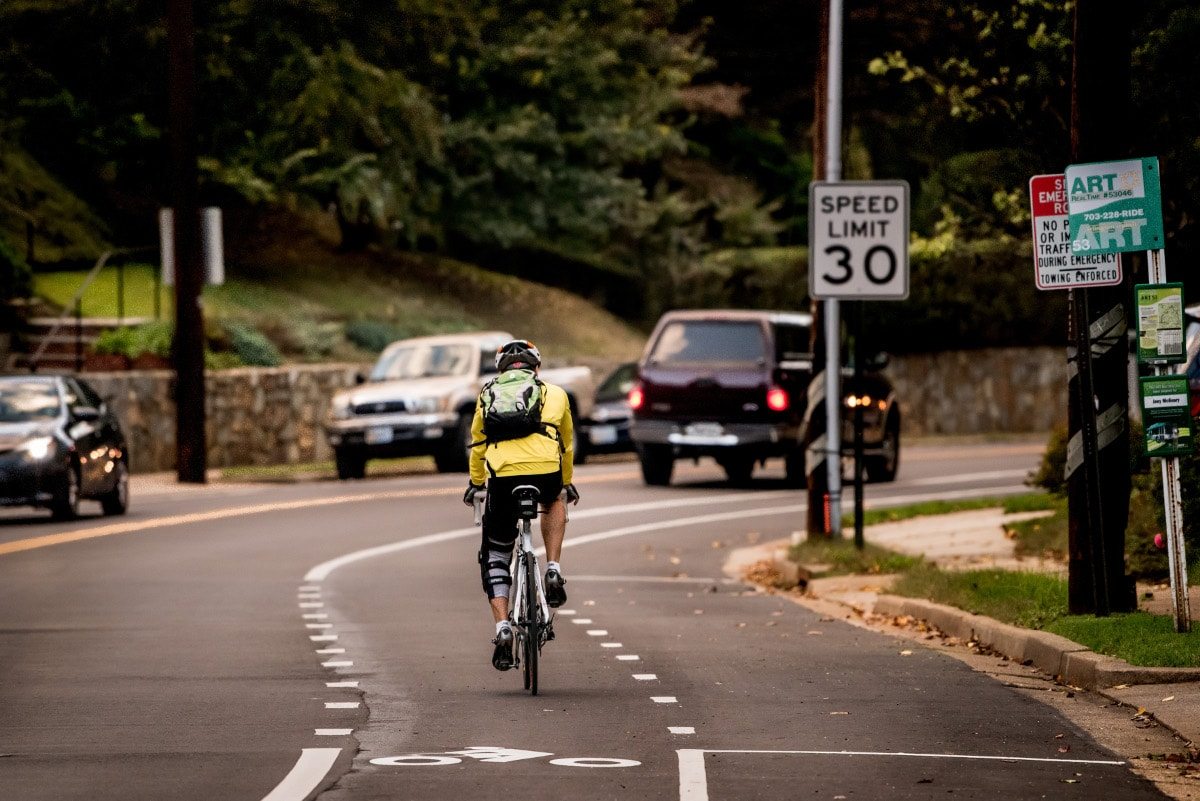 Bicycle lanes are striped or otherwise separated areas on the roadway designated for the preferential use of bicyclists over motor vehicles. On most streets, bicycle lanes are provided between the curb and the right travel lane, or between the curbside parking lane and the right travel lane. Bicyclists are not required to ride in a bicycle lane if one is available. Bicyclists are permitted to ride on the roadway in the bicycle lanes or with mixed traffic, even if a bicycle lane is available. A cyclist may choose to ride outside the bicycle lane if the lane is blocked, or if they feel unsafe riding in the lane for any reason. Cyclists should take the lane if it is the safer option for any reason. Motorists may not drive, stop or park in a bicycle lane. Drivers may cross a bicycle lane to access on-street parking but may not stop or stand in a bicycle lane for any reason. When making a right turn from a street with a bicycle lane, drivers should check their mirrors and merge into the bicycle lane to make their turn. This maneuver helps reduce the likelihood of so-called “right-hook” collisions, where a driver turns right across a bicycle lane and strikes a cyclist in the bicycle lane. Regardless of why a driver is crossing a bicycle lane, drivers must always yield to bicyclists when crossing a bicycle lane. There are many criteria that inform the decision to install a bicycle lane or other bicycling facility. First and foremost, the street must be wide enough to accommodate the bicycle lane in addition to the regular travel lanes. Since Arlington does not have a dedicated program to rebuild roadways specifically to install bicycle facilities, engineers must work within the existing roadway dimensions for the most part. As a general rule, if it is possible to install a bicycle lane or other bicycle facility on a roadway, Arlington will make every effort to do so in order to make cycling safer and to encourage more people to bike more often.
Bicycle lanes are striped or otherwise separated areas on the roadway designated for the preferential use of bicyclists over motor vehicles. On most streets, bicycle lanes are provided between the curb and the right travel lane, or between the curbside parking lane and the right travel lane. Bicyclists are not required to ride in a bicycle lane if one is available. Bicyclists are permitted to ride on the roadway in the bicycle lanes or with mixed traffic, even if a bicycle lane is available. A cyclist may choose to ride outside the bicycle lane if the lane is blocked, or if they feel unsafe riding in the lane for any reason. Cyclists should take the lane if it is the safer option for any reason. Motorists may not drive, stop or park in a bicycle lane. Drivers may cross a bicycle lane to access on-street parking but may not stop or stand in a bicycle lane for any reason. When making a right turn from a street with a bicycle lane, drivers should check their mirrors and merge into the bicycle lane to make their turn. This maneuver helps reduce the likelihood of so-called “right-hook” collisions, where a driver turns right across a bicycle lane and strikes a cyclist in the bicycle lane. Regardless of why a driver is crossing a bicycle lane, drivers must always yield to bicyclists when crossing a bicycle lane. There are many criteria that inform the decision to install a bicycle lane or other bicycling facility. First and foremost, the street must be wide enough to accommodate the bicycle lane in addition to the regular travel lanes. Since Arlington does not have a dedicated program to rebuild roadways specifically to install bicycle facilities, engineers must work within the existing roadway dimensions for the most part. As a general rule, if it is possible to install a bicycle lane or other bicycle facility on a roadway, Arlington will make every effort to do so in order to make cycling safer and to encourage more people to bike more often.
Buffered Bike Lanes
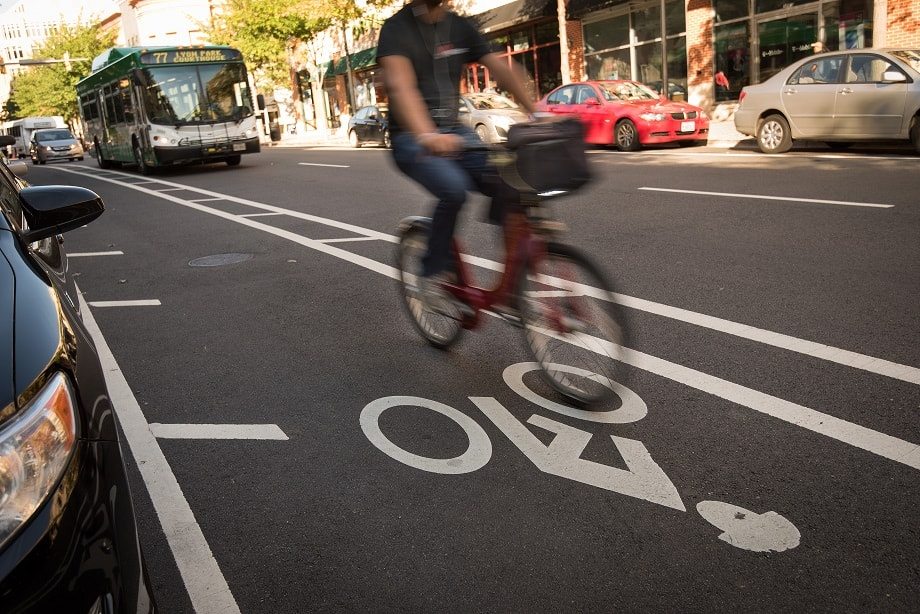 Buffered bicycle lanes provide the same functions as a standard bicycle lane with the addition of marked buffer space on one or both sides of the lane. Depending on the location there may be buffers provided between the bicycle lane and the travel lane, between the bicycle lane and on-street parking, or both. The buffered bike, offers a more comfortable riding environment that is consistent with Arlington’s “complete streets” policy of maximizing the utility and safety of our streets for all road users. The addition of buffered bike lanes is part of Arlington’s ongoing commitment to make the County a bike-friendly community where cycling is a safe, convenient and enjoyable form of transportation and recreation. Drivers should treat these lanes the same as any other bicycle lane. Drivers should only cross them when turning or parking, and drivers should never stop, stand, or park within a bicycle lane. To parallel park, a motorist may position themselves temporarily as you normally would outside of the parking area to pull in to the space. It’s okay to make those maneuvers within the buffered bike lane area.
Buffered bicycle lanes provide the same functions as a standard bicycle lane with the addition of marked buffer space on one or both sides of the lane. Depending on the location there may be buffers provided between the bicycle lane and the travel lane, between the bicycle lane and on-street parking, or both. The buffered bike, offers a more comfortable riding environment that is consistent with Arlington’s “complete streets” policy of maximizing the utility and safety of our streets for all road users. The addition of buffered bike lanes is part of Arlington’s ongoing commitment to make the County a bike-friendly community where cycling is a safe, convenient and enjoyable form of transportation and recreation. Drivers should treat these lanes the same as any other bicycle lane. Drivers should only cross them when turning or parking, and drivers should never stop, stand, or park within a bicycle lane. To parallel park, a motorist may position themselves temporarily as you normally would outside of the parking area to pull in to the space. It’s okay to make those maneuvers within the buffered bike lane area.
HAWK Beacon
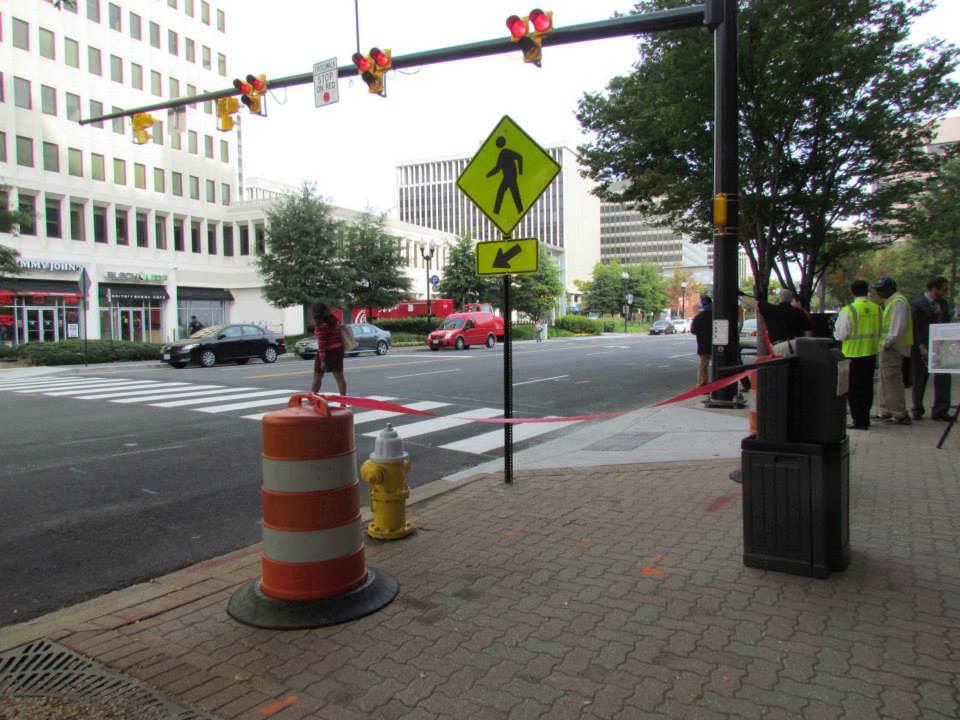 A HAWK Beacon (High-Intensity Activated Crosswalk) is a device to assist pedestrians and cyclists to safely cross busy streets.Example of a HAWK Beacon. While different in appearance to the driver, to the pedestrian or cyclist HAWKs work the same as button-activated traffic signals. It stops traffic with a red light allowing pedestrians and cyclists to cross safely. At rest, HAWKs remain dark. HAWKs can be triggered automatically or manually with a push button. It will then go through a series of yellow and red sequences requiring motorists to slow down and stop. After pedestrians and cyclists cross, the HAWK will go dark again, allowing motorists to continue through the intersection. HAWK Beacons can be installed at mid-block locations, or at an intersection of an arterial road with a smaller side street. Unlike a standard traffic signal, intersections with HAWK beacons do not have any traffic signals facing the side street approaches. Any side street that is currently controlled by a stop sign will continue to be controlled by a stop sign even after a HAWK beacon is in place.
A HAWK Beacon (High-Intensity Activated Crosswalk) is a device to assist pedestrians and cyclists to safely cross busy streets.Example of a HAWK Beacon. While different in appearance to the driver, to the pedestrian or cyclist HAWKs work the same as button-activated traffic signals. It stops traffic with a red light allowing pedestrians and cyclists to cross safely. At rest, HAWKs remain dark. HAWKs can be triggered automatically or manually with a push button. It will then go through a series of yellow and red sequences requiring motorists to slow down and stop. After pedestrians and cyclists cross, the HAWK will go dark again, allowing motorists to continue through the intersection. HAWK Beacons can be installed at mid-block locations, or at an intersection of an arterial road with a smaller side street. Unlike a standard traffic signal, intersections with HAWK beacons do not have any traffic signals facing the side street approaches. Any side street that is currently controlled by a stop sign will continue to be controlled by a stop sign even after a HAWK beacon is in place.
Green Bike Lanes
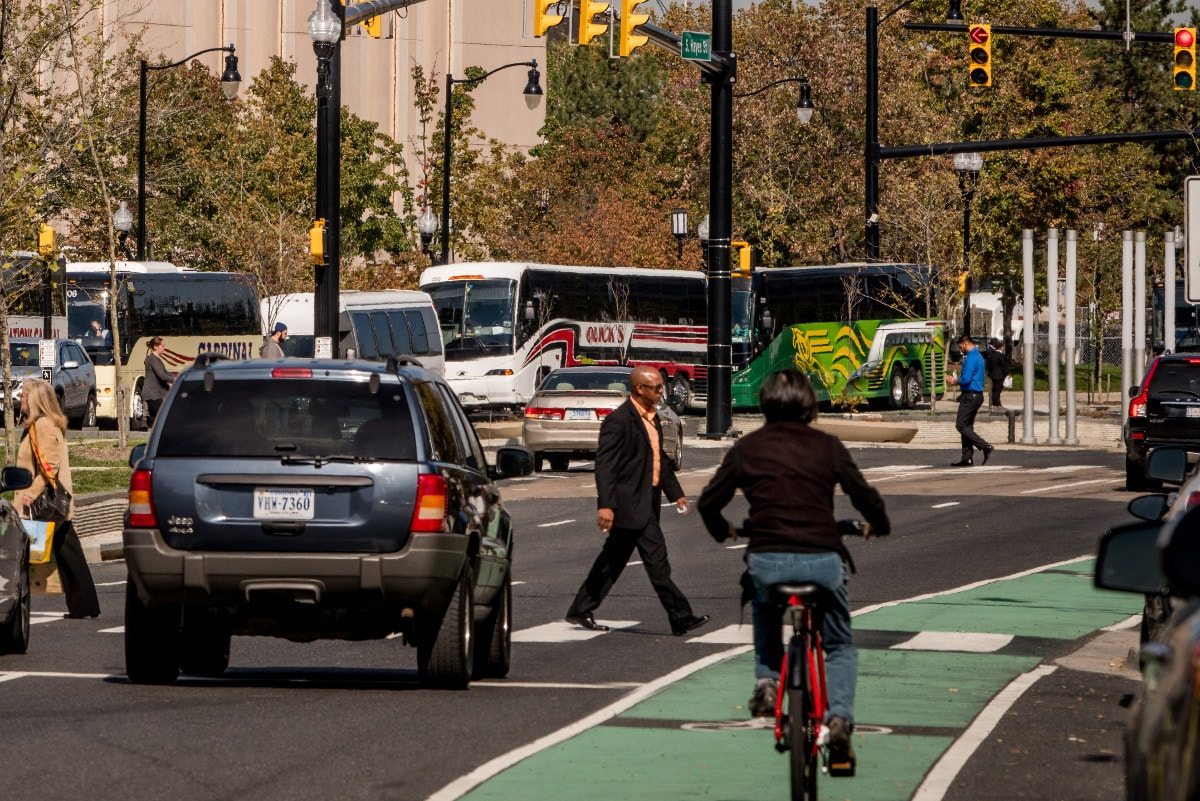 Green bikes lanes (literally, green paint within the existing bike lanes) are relatively new in Arlington. They help reinforce the presence of the bike lane in places where the street markings might not get noticed by drivers. Arlington County has started using them at specific, critical locations where bike lanes and drive lanes cross each other in unusual configurations, such as at “Y” intersections or at the start of some dedicated right turn lanes. The green coating, called “StreetBond CL” was created to hold up well to traffic wear and tear. It is also engineered to maintain the same or higher levels of friction as the asphalt itself. This is an important safety consideration for cyclists, particularly in wet weather. New York City has been using this product (and this color) to mark bike lanes for several years.
Green bikes lanes (literally, green paint within the existing bike lanes) are relatively new in Arlington. They help reinforce the presence of the bike lane in places where the street markings might not get noticed by drivers. Arlington County has started using them at specific, critical locations where bike lanes and drive lanes cross each other in unusual configurations, such as at “Y” intersections or at the start of some dedicated right turn lanes. The green coating, called “StreetBond CL” was created to hold up well to traffic wear and tear. It is also engineered to maintain the same or higher levels of friction as the asphalt itself. This is an important safety consideration for cyclists, particularly in wet weather. New York City has been using this product (and this color) to mark bike lanes for several years.
Multi-Use Trails
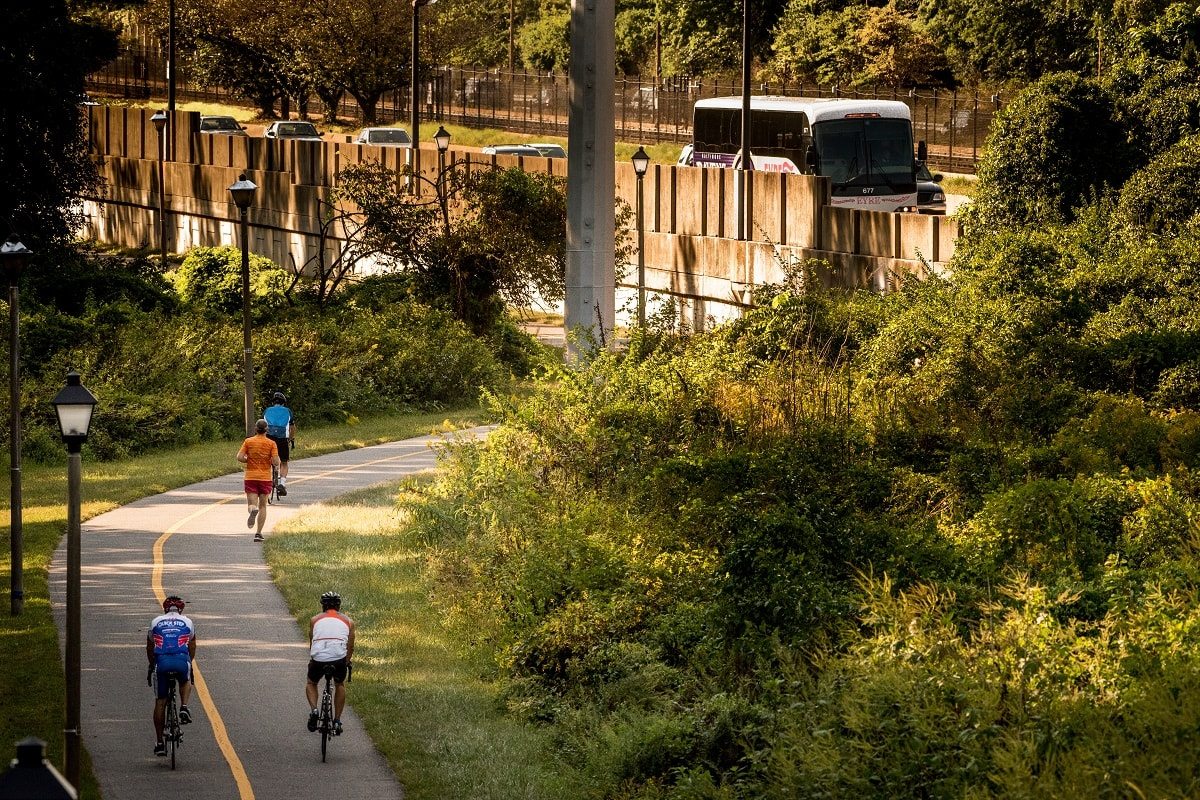 Arlington County has an extensive network of bicycle infrastructure, including 50 miles of shared-use off-street trails. These multi-use trails are generally 10 feet wide with a solid yellow line striped down the middle to separate users. Trails are used by a wide variety of types of users, including children and adults, ranging from pedestrians, dog walkers, runners, and people on bikes. All users should stay to the right and pass when clear, after giving an audible warning. When walking a dog on a multi-use trail, please be considerate of others and do not allow the leash to extend across the travel lane. Cars and other motor vehicles are prohibited from operating on the off-street trails. To report a problem or maintenance issue on Arlington’s trails, see the About Us page.
Arlington County has an extensive network of bicycle infrastructure, including 50 miles of shared-use off-street trails. These multi-use trails are generally 10 feet wide with a solid yellow line striped down the middle to separate users. Trails are used by a wide variety of types of users, including children and adults, ranging from pedestrians, dog walkers, runners, and people on bikes. All users should stay to the right and pass when clear, after giving an audible warning. When walking a dog on a multi-use trail, please be considerate of others and do not allow the leash to extend across the travel lane. Cars and other motor vehicles are prohibited from operating on the off-street trails. To report a problem or maintenance issue on Arlington’s trails, see the About Us page.
Protected Bike Lanes
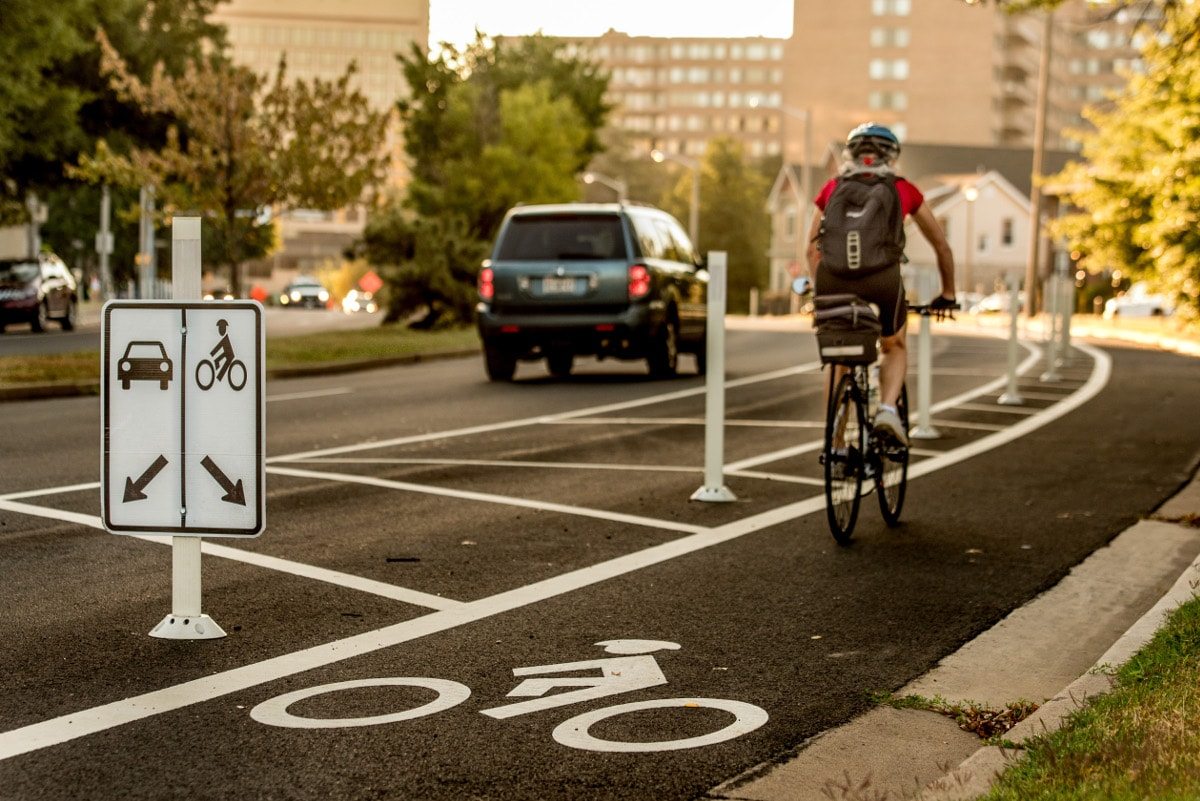 Protected bike lanes, also known as cycletracks, green lanes and separated bike lanes, provide physical separation between people on bikes and motor vehicles. The separation can be provided in a number of ways including:
Protected bike lanes, also known as cycletracks, green lanes and separated bike lanes, provide physical separation between people on bikes and motor vehicles. The separation can be provided in a number of ways including:
- Plastic bollards or “flex posts”
- Landscaping and large planters
- Curbs
- Car parking
Arlington’s first protected bike lanes were installed in 2014. Between 2016-2019, additional protected bike lanes were installed in the following locations:
- S Hayes Street in Pentagon City – between 15th St S & 18th St S
- Army Navy Drive in Pentagon City – between S Nash St & S Joyce St
- S Eads Street in Crystal City – between 12th St S & 22nd St S, and between Fort Scott Dr & S Glebe Rd
- Wilson Boulevard in Rosslyn – westbound between N Oak St & N Courthouse Rd
- Clarendon Blvd in Rosslyn – eastbound
- N Quincy Street in Ballston – between N Glebe Rd & 9th St N
- Fairfax Drive in Ballston – westbound between N Glebe Rd & N Wakefield St
- N Veitch Street in Courthouse – between Wilson Blvd & Lee Hwy
- N Pershing Drive in Lyon Park – between Washington Blvd & N Barton St
There are many other successful examples around the country, including in New York City, Chicago, San Francisco, Austin, Memphis, and Indianapolis.
Sharrows
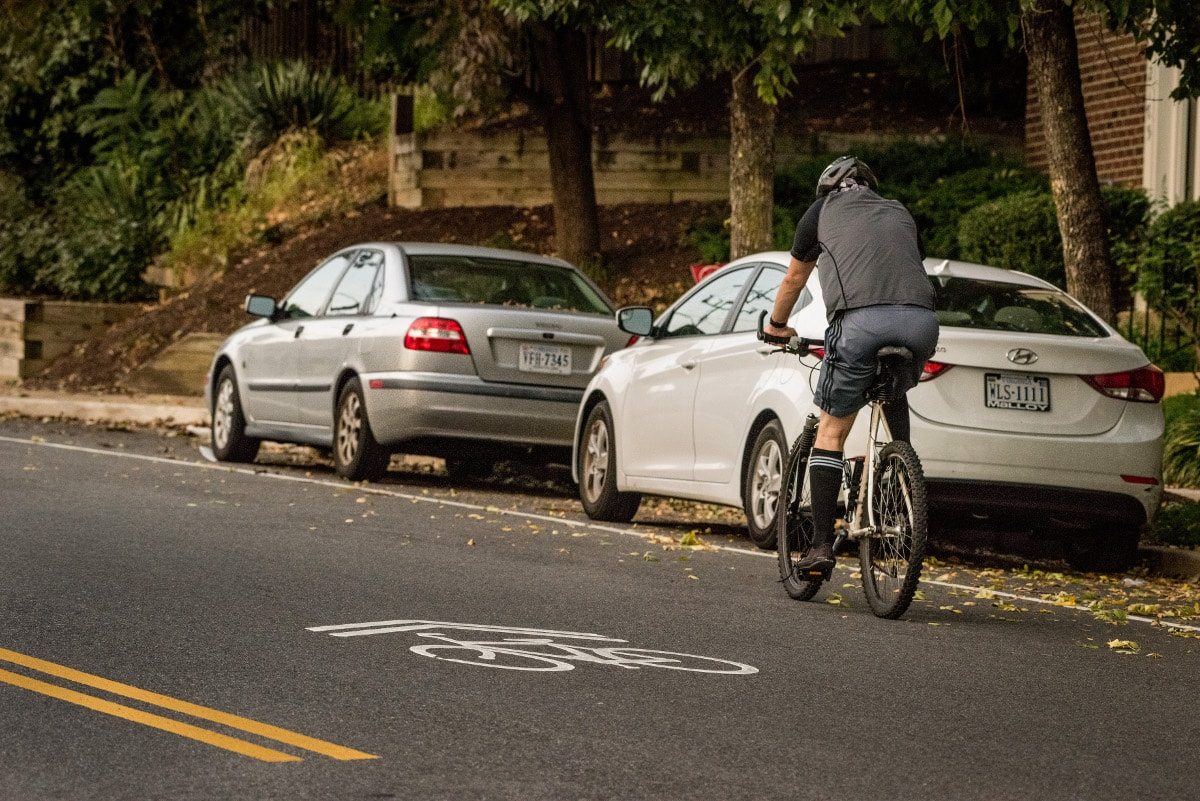 Shared-lane markings or “sharrows,” are intended to help motorists and cyclists safely share and navigate streets. The sharrows show cyclists where to be in the road (aligned with the middle of the chevron markings), and along with “Bikes may use full lane” signs, remind drivers that the presence of bicyclists is to be expected. Sharrows are different from bike lanes, which are reserved exclusively for bicyclists and are marked by a solid white line and a bicycle symbol. They also show where cyclists can ride on the street without being hit by a suddenly-opened car door. Although it is the responsibility of the motorist to check before opening their door, riding too close to parked cars (in the “door zone”) is still a common mistake bicyclists make that can lead to serious injury.
Shared-lane markings or “sharrows,” are intended to help motorists and cyclists safely share and navigate streets. The sharrows show cyclists where to be in the road (aligned with the middle of the chevron markings), and along with “Bikes may use full lane” signs, remind drivers that the presence of bicyclists is to be expected. Sharrows are different from bike lanes, which are reserved exclusively for bicyclists and are marked by a solid white line and a bicycle symbol. They also show where cyclists can ride on the street without being hit by a suddenly-opened car door. Although it is the responsibility of the motorist to check before opening their door, riding too close to parked cars (in the “door zone”) is still a common mistake bicyclists make that can lead to serious injury.
Sidewalks
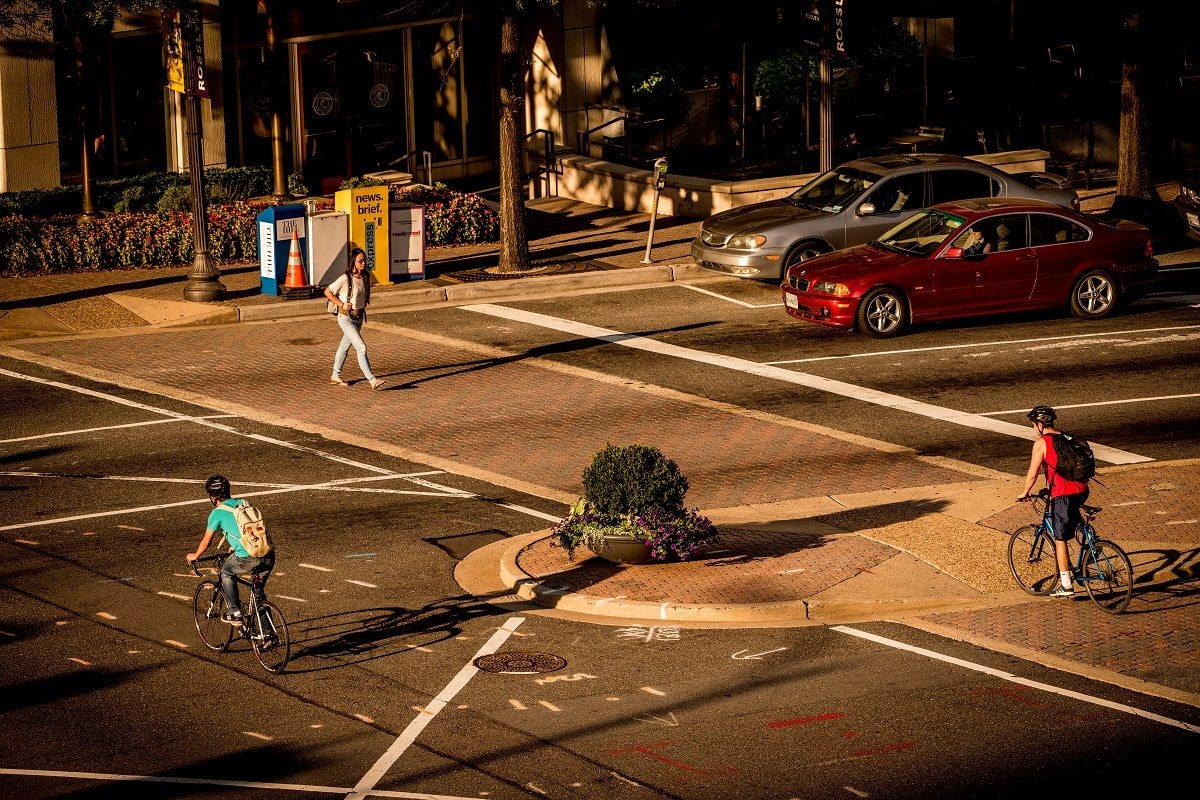 A sidewalk is defined as the portion of a street between the curb lines, or the lateral lines of a roadway, and the adjacent property lines, intended for use by pedestrians. In Arlington County it is legal for a person of a bicycle to use a sidewalk, unless it is otherwise signed as prohibited. Bicyclists and other users on sidewalks, shared use paths, and crosswalks have all the rights and duties of a pedestrian under the same circumstance. It is not, however, recommended for most bicyclists to ride on sidewalks as it increases of the chances of a collision with pedestrian and at intersections with cars where motorists may not be expecting a fast moving bike to appear. People on bikes are encouraged to be courteous and to always yield to people on foot.
A sidewalk is defined as the portion of a street between the curb lines, or the lateral lines of a roadway, and the adjacent property lines, intended for use by pedestrians. In Arlington County it is legal for a person of a bicycle to use a sidewalk, unless it is otherwise signed as prohibited. Bicyclists and other users on sidewalks, shared use paths, and crosswalks have all the rights and duties of a pedestrian under the same circumstance. It is not, however, recommended for most bicyclists to ride on sidewalks as it increases of the chances of a collision with pedestrian and at intersections with cars where motorists may not be expecting a fast moving bike to appear. People on bikes are encouraged to be courteous and to always yield to people on foot.
Wayfinding
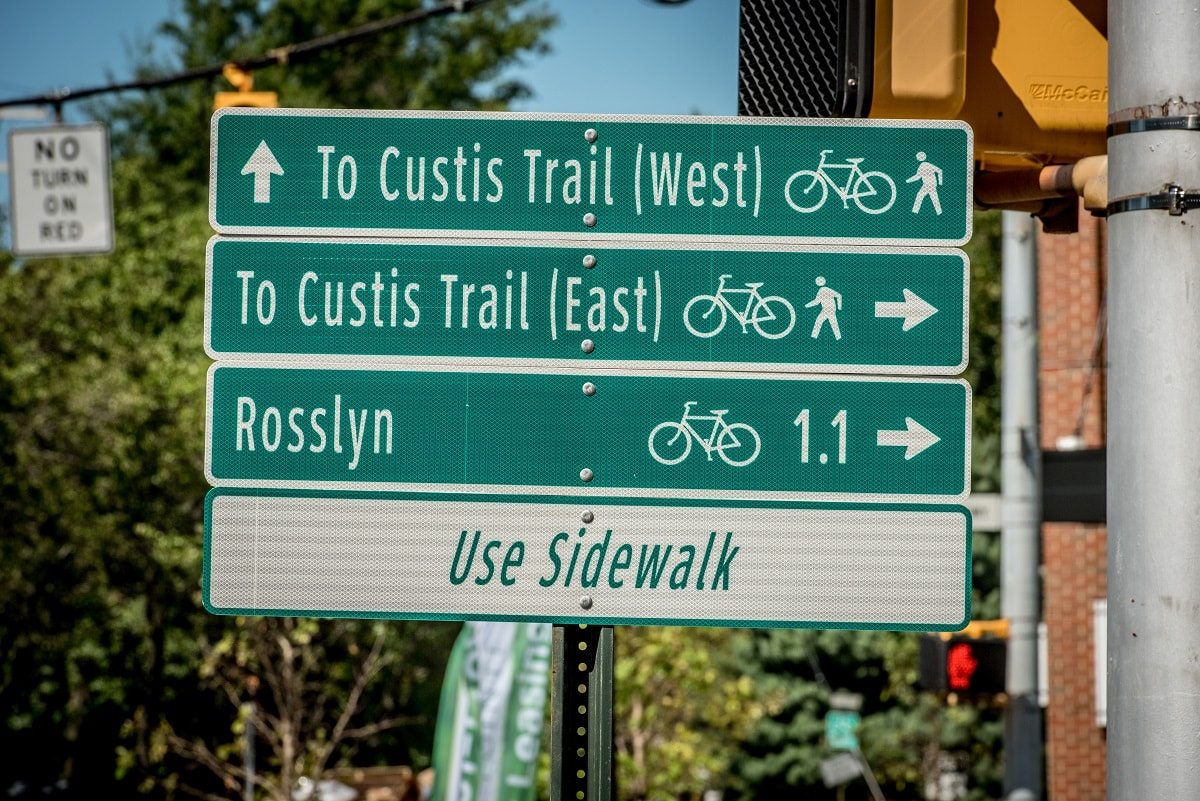 Arlington County has placed directional wayfinding signs along bicycle and pedestrian routes throughout the Rosslyn-Ballston corridor, with an eventual rollout to other areas of County. These wayfinding signs help cyclists and pedestrians more easily navigate Arlington’s 100 miles of multi-use trails, on-street bike lanes and designated bike routes, and its commercial districts. The system conforms to national standards for directional signage and uses similar materials, layouts, and fonts as roadway signs to increase visibility. Frequent spacing of signs increase cyclist and pedestrian confidence when in an unfamiliar area, and each sign reinforces location, distance, and destination information.
Arlington County has placed directional wayfinding signs along bicycle and pedestrian routes throughout the Rosslyn-Ballston corridor, with an eventual rollout to other areas of County. These wayfinding signs help cyclists and pedestrians more easily navigate Arlington’s 100 miles of multi-use trails, on-street bike lanes and designated bike routes, and its commercial districts. The system conforms to national standards for directional signage and uses similar materials, layouts, and fonts as roadway signs to increase visibility. Frequent spacing of signs increase cyclist and pedestrian confidence when in an unfamiliar area, and each sign reinforces location, distance, and destination information.
Sign location placement guidelines:
-
- Major Destinations and Routes: Direction in Arlington is often established by major destinations, like urban villages such as Rosslyn, Ballston and East Falls Church. Similarly, signing corridors, such as the Custis Trail, also help establish direction.
- Neighborhoods and Local Destinations: Smaller signs, sorted by direction (straight, right or left) and by distance (near to far), act like “breadcrumbs” and be placed at junctions where a decision must be decided about which direction to take.
- Strategic Signage: To minimize sign clutter and maintenance costs, only the most popular or useful destinations have been chosen as to not “over-sign” or contribute to sign clutter.
Additional Resources
Shared Micro-Mobility Devices
Shared Micro-Mobility Devices include regular pedal bikes, electric power-assisted bicycles (e-bikes), motorized scooters (e-scooters), and motorized skateboards.
On Nov. 16, 2019, the County Board adopted regulations for Micro-Mobility Devices that will allow their use on sidewalks (with limitations), trails, and bike lanes, unless specifically signed or marked otherwise. The County’s adopted ordinance went into effect on Dec. 31, 2019.
Visit the County’s website for more information.
Bicycle Parking
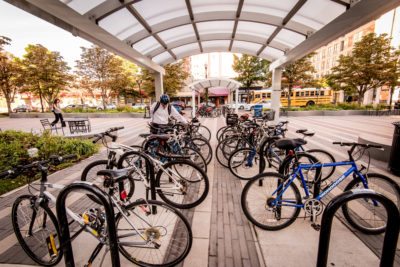 With hundreds of bike racks throughout the County, Arlington aims to make cycling an easy and preferred method of travel. Being able to park a bicycle quickly, in a well-lit location, and near your destination is key. Arlington requires new office, residential, and retail development to provide sufficient bike parking, shower, and locker facilities with one of the most progressive requirements of its kind. Do you know of a place in Arlington that needs a bike rack? Help make Arlington even more bike-friendly by letting us know.
With hundreds of bike racks throughout the County, Arlington aims to make cycling an easy and preferred method of travel. Being able to park a bicycle quickly, in a well-lit location, and near your destination is key. Arlington requires new office, residential, and retail development to provide sufficient bike parking, shower, and locker facilities with one of the most progressive requirements of its kind. Do you know of a place in Arlington that needs a bike rack? Help make Arlington even more bike-friendly by letting us know.
Are you a developer, architect, property manager, or a construction professional? Arlington County’s Bicycle Parking Standards guide outlines the current County design and installation standards and procedures for secure and visitor bicycle parking in both new and retrofitted construction. The guide also provides knowledge to design, install, and maintain great bicycle parking facilities.
Bike Shops
Arlington has a wealth of local bike shops throughout the County, with helpful staff to answer any and all questions you might have about types of bikes and provide services and repairs to your bikes, as needed.
Fixit Stands
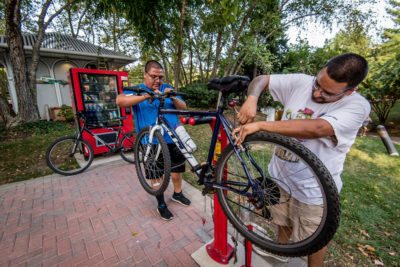 Arlington has installed bike Fixit Stands around the county that include an air pump for filling up tires and tools for basic repairs and adjustments. The stands are free and available to everyone at any time. Currently there are Fixit Stands near the Ballston, Clarendon, and Pentagon City Metro stations. There is also a Fixit Stand at the Glencarlyn Park at Columbia Pike and S Four Mile Run Drive and one at the George Mason University School of Law. To use the stands, it’s recommended to hang the bicycle by the seat, seatpost or seat tube to gain easy and access to the entirety of the bike.
Arlington has installed bike Fixit Stands around the county that include an air pump for filling up tires and tools for basic repairs and adjustments. The stands are free and available to everyone at any time. Currently there are Fixit Stands near the Ballston, Clarendon, and Pentagon City Metro stations. There is also a Fixit Stand at the Glencarlyn Park at Columbia Pike and S Four Mile Run Drive and one at the George Mason University School of Law. To use the stands, it’s recommended to hang the bicycle by the seat, seatpost or seat tube to gain easy and access to the entirety of the bike.
These stands compliment a similar bike maintenance Fixit stand at the Crystal City Water Park, which was installed through a partnership between the Crystal City BID and Phoenix Bikes, and is located next to the bicycle accessory vending machine.
Documentaries
Arlington Passages
At BikeArlington, we love the stories behind the people and their bikes–so much so, in fact, that we created a series of short films. Six films in total, the series lets our neighbors share their hopes and challenges and reminds us what makes out community so awesome. Hint: It’s the people!
Passages Accolades
We are honored by the awards and warm reception that Arlington Passages has received:
BikeSwell – Smart Movement in Arlington
This 30 minute documentary brings bicycling to the forefront of the conversation about how people get around in Arlington. It features local bike advocacy rock stars and highlights the triumphs and tribulations of making Arlington a premier bicycle friendly community.







